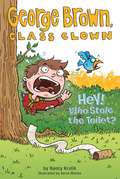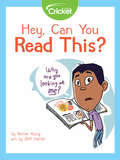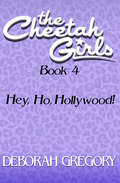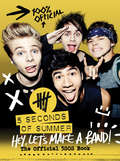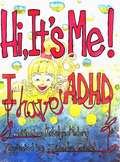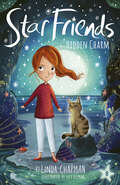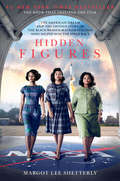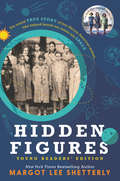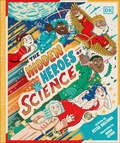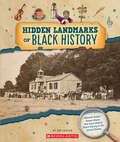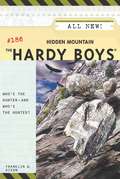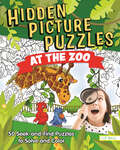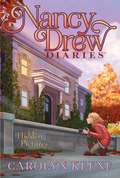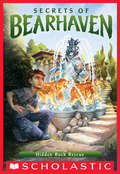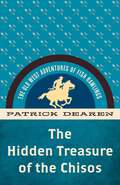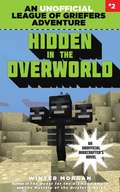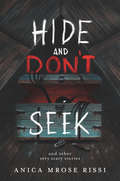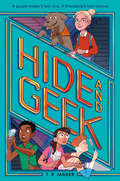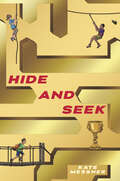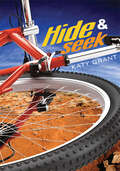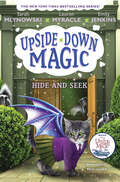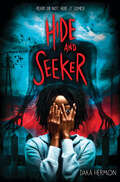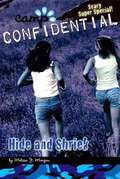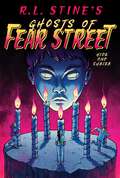- Table View
- List View
Hey! Who Stole the Toilet? #8
by Nancy KrulikGeorge goes WILD in the wild!In the eighth book of Nancy Krulik's popular George Brown, Class Clown series, George Brown is going on his first camping trip with his scout troop. After a trial run with his dad in the backyard, George can't wait to head out into the wilderness. It doesn't take long, though, for the Super Burp to drown out the soothing sounds of babbling brooks and bird calls. Too bad there's no such thing as a bug spray for burps! .
Hey, Can You Read This?
by Rachel YoungLearn about the science behind reading and how the cerebellum, neurons, and optic nerve all work together to make words come alive.
Hey, Dad!
by Brian DoyleIn Brian Doyle's first book, teenager Megan dreads making a road trip all the way across the country with her parents and younger brother Ryan. Her father's tendency to joke doesn't help. She'd rather stay home and be president of the Down with Boys Club any day. But she has no choice. She has to endure endless driving, being trapped in a car with her younger brother, and the great view of the transport trucks that box them in on all sides. But as the days go by Megan begins to change her mind. There are constant reports on the radio about forest fires across huge parts of the country. There is the old lady who owns a motel and is so glad to have the family stay there because the recent death of her husband has left her lonely and sad. There are the cute boys at a lakeside stop. All these experiences jumble together in her head. Love and death, family and friends, what matters and what doesn't, fill her mind as the vast country unrolls before the windows. Will a final confrontation with her father drive Megan over the edge?
Hey, Ho, Hollywood!: Hey, Ho, Hollywood (The Cheetah Girls #4)
by Deborah GregoryIn the fourth installment of the series that inspired the Disney Channel films, the unstoppable teens take the next step to pop stardom: La La Land! The hairdresser of Galleria&’s mom, Pepto B., gets a tip. Kahlua, the teenage R&B diva whose last single topped the charts, is coming to town. The Cheetahs hatch a plan—&“Mission Kahlua&”—in which they rock Pepto B.&’s salon with their newest song, &“More Pounce to the Ounce.&” Kahlua hooks up a meeting with her record label executives in Hollywood. The girls snag a record deal and are ready to prove to the world that every cheetah has its day! Praise for the Cheetah Girls series &“A new series just for &‘divettes-in-training&’ . . . A light read for young teens who dream of stardom.&” —School Library Journal
Hey, Let's Make a Band!
by 5 Seconds of SummerHi everyone,This book is pretty much our official story so far. It really does seem only like last week we played our first gig at the Annandale Hotel in Sydney. Since then we've been given the opportunity to turn into the people and musicians we wanted to be.The people who gave us the opportunity were the fans. So this book is like a thank-you. We want everyone to know the story of how four western Sydney teenagers picked up their instruments and dreamed of being one of the biggest bands in the world. There are also some embarrassing photos of us derping around and some facts that some of us didn't even know. So we hope you enjoy it!Love, cal, luke, ash, and mike x
Hi It's Me! I Have ADHD
by Katelyn MabryFrom thinking fast, to thinking slow, from feeling high, to feeling low; this busy child wishes adults could see inside her head. Based on the author's personal experience with Attention Deficit Hyperactive Disorder, "Hi, It's Me" shares the thoughts, feelings, emotions, and experiences of a child dealing with the many challenges of ADHD. Offering insight into the world of ADHD and presenting a list of tips and a printable coloring/journal pages; this rhyming picture book helps children struggling with ADHD feel empowered. It lets kids know that the diagnosis does NOT define them and that there are so many gifts beneath the diagnosis. It communicates that they can find peace knowing they're not alone in how they think and feel.
Hidden Charm (Star Friends)
by Linda ChapmanIn the 8th Star Friends adventure, business is slow at the Copper Kettle café until suddenly, mysteriously, everyone wants cakes! Can Mia, Sita, Lexi, and Violet figure out what's going on? With black-and-white illustrations throughout.In this 8th Star Friends adventure, business is slow at the Copper Kettle café until one day when suddenly, mysteriously, everyone wants cakes! In fact, the townspeople want the cakes so much that they get angry when they can't have them. Mia. Sita, Lexi, and Violet suspect that dark magic might be at work—but can they figure out who is behind it with the help of their Star Animals? With black-and-white illustrations throughout.In the Star Friends chapter book series, Mia and her friends Lexi, Sita, and Violet all discover that they are Star Friends -- they can communicate with the animals that have traveled from the Star World. The animals show the girls how to use their unique magic abilities to do good. A whole world of magical adventures awaits!
Hidden Figures: The American Dream and the Untold Story of the Black Women Mathematicians Who Helped Win the Space Race
by Margot Lee Shetterly<P>The phenomenal true story of the black female mathematicians at NASA whose calculations helped fuel some of America's greatest achievements in space. Soon to be a major motion picture starring Taraji P. Henson, Octavia Spencer, Janelle Monae, Kirsten Dunst, and Kevin Costner. <P>Before John Glenn orbited the earth, or Neil Armstrong walked on the moon, a group of dedicated female mathematicians known as "human computers" used pencils, slide rules and adding machines to calculate the numbers that would launch rockets, and astronauts, into space. Among these problem-solvers were a group of exceptionally talented African American women, some of the brightest minds of their generation. <P>Originally relegated to teaching math in the South's segregated public schools, they were called into service during the labor shortages of World War II, when America's aeronautics industry was in dire need of anyone who had the right stuff. Suddenly, these overlooked math whizzes had a shot at jobs worthy of their skills, and they answered Uncle Sam's call, moving to Hampton, Virginia and the fascinating, high-energy world of the Langley Memorial Aeronautical Laboratory. <P>Even as Virginia's Jim Crow laws required them to be segregated from their white counterparts, the women of Langley's all-black "West Computing" group helped America achieve one of the things it desired most: a decisive victory over the Soviet Union in the Cold War, and complete domination of the heavens. <P>Starting in World War II and moving through to the Cold War, the Civil Rights Movement and the Space Race, Hidden Figures follows the interwoven accounts of Dorothy Vaughan, Mary Jackson, Katherine Johnson and Christine Darden, four African American women who participated in some of NASA's greatest successes. It chronicles their careers over nearly three decades they faced challenges, forged alliances and used their intellect to change their own lives, and their country's future.
Hidden Figures: The Untold True Story of Four African-American Women Who Helped Launch Our Nation Into Space
by Margot Lee ShetterlyNew York Times bestselling author Margot Lee Shetterly's book is now available in a new edition perfect for young readers. This is the amazing true story of four African-American female mathematicians at NASA who helped achieve some of the greatest moments in our space program. <p><p>Before John Glenn orbited the earth, or Neil Armstrong walked on the moon, a group of dedicated female mathematicians known as "human computers" used pencils, slide rules, and adding machines to calculate the numbers that would launch rockets, and astronauts, into space. <p><p>This book brings to life the stories of Dorothy Vaughan, Mary Jackson, Katherine Johnson, and Christine Darden, four African-American women who lived through the civil rights era, the Space Race, the Cold War, and the movement for gender equality, and whose work forever changed the face of NASA and the country.
Hidden Heroes of Science: Shining a Light on the Unknown Trailblazers of the Scientific World
by Peter GallivanUncover the unnamed heroes who contributed to some of our world’s most important science.Explore the hidden heroes that created the miraculous things we find all around us in this science book for children aged 7-9.Do you ever find yourself feeling curious about who created the science behind some of our most impressive structures? Or wonder who it was that invented the equipment you find in your classroom? Well, wonder no more. This groundbreaking book covers all the lost contributors to the world’s most important scientific discoveries.This science book for children offers:Content produced by an exciting partnership with The Royal Institution, world leaders in science.An exciting introduction to lesser-known scientific figures such as Maria Merian, Gregor Mendel, and Percy Julian.Inspirational stories from pioneering scientists who faced adversity, to unsung innovators who paved the way for modern advancements.For curious children who have always wanted to know who it was that created coding, or how on earth the Egyptian Pyramids were built so long ago and yet still look brand new, The Royal Institution; the home of science, has all the answers.
Hidden Landmarks of Black History (From the Archives)
by Jay LeslieA perfect book for young readers to discover lesser-known places that have shaped Black history in the United States.The square in New Orleans where enslaved people met to sing, dance, and play music together. The oldest Black church still standing in the United States. The first Freedmen’s colony in the country. Throughout history, Black people have founded communities, churches, and more to fight for equality. Celebrate little-known historic sites like these and learn about their social impact on American history in Hidden Landmarks of Black History.ABOUT THIS SERIES:This brand-new series is rooted in a profound commitment to shedding light on some of the important—and often lesser-known—aspects of Black history. From the Archives features landmarks, events, people, and artistic endeavors that have played a significant role in the Black experience in America and offers a chance to celebrate them. Written in a vivid, engaging style and featuring a colorful combination of photos and illustrations, each title serves as a powerful vehicle for education, inspiration, and empowerment for young readers.
Hidden Mountain (Hardy Boys #186)
by Franklin W. DixonHere today -- but where tomorrow? Frank and Joe have gone hunting -- but instead of sniffing out wildlife, they're out to find the Wilkersons. Darren Wilkerson, the Hardys' classmate, and his family were living in Bayport under the safety of the Witness Protection Program -- until someone found them out. Unable to get in touch with the government, the Wilkersons were forced to flee without its assistance. Now Darren and his family have made it to Canada, but they're not yet out of the woods. The Hardys quickly arrive on the scene to help. But just when they're hot on the Wilkersons' trail, they get caught in a trap. Can Frank and Joe escape in time to save the Wilkersons from their predators?
Hidden Picture Puzzles at the Zoo: 50 Seek-and-Find Puzzles to Solve and Color
by Liz BallEnjoy hours of fun while learning about zoo animals with this volume of fifty seek-and-find puzzles to solve and color! It's time to bust out your binoculars and go wild! Spend hours at the zoo searching for over a thousand hidden animals and objects in fifty exciting seek-and-find puzzles. Each puzzle is in black and white, so once you find all the secret items, you can bring the pages to life by coloring them! Along the way, you'll also discover crazy cool facts about zoo animals, from bats and frogs to hippos and manatees. With so much to discover, so much to color, and so much to learn, you'll never want to leave the zoo! · Solve fifty seek-and-find puzzles · Look for over a thousand hidden animals and objects · Color each puzzle page · Read tons of zoo animal fun facts · Enjoy hours of fun! This is a fixed-format ebook, which preserves the design and layout of the original print book.
Hidden Pictures (Nancy Drew Diaries #19)
by Carolyn KeeneNancy, Bess, and George must find the truth behind a photographic mystery in this nineteenth book of the Nancy Drew Diaries, a fresh approach to the classic mystery series.Nancy and her friends are spending the weekend in a small mountainside town called Shady Oaks. The local museum is displaying a never-before-seen collection from famous nature photographer, Christopher DeSantos. So the usually sleepy town is now filled with tourists. But it&’s not just the dramatic lighting of the old black and white photographs that people have come to see. Newspapers all over the country have picked up the story of two visitors who went missing in Shady Oaks only to turn up in the old DeSantos photographs, seemingly frozen in time. What&’s more, there was a rumor that DeSantos was cursed by his former partner after a disagreement. Now everyone is wondering if the legend is real. Nancy, Bess, and George are convinced that there is another explanation to be found. But it quickly becomes clear that someone is making sure they don&’t find it. Can these three teenage sleuths solve this mystery before it&’s too late?
Hidden Rock Rescue (Secrets of Bearhaven #3)
by K. E. RochaAn incredible new adventure story for fans of Narnia and Wolves of the Beyond!Ever since Spencer Plain's parents disappeared, he's been staying in Bearhaven--a secret city where bears talk, go to school, develop secret technology, and plan missions to rescue others who need help.Spencer's been planning, too. He's in training as an operative with the Bear Guard, so that he's ready to go help rescue his parents. They've been captured by Pam, who runs an illegal ring of rare animal trading and has been training an army of bears under his control. The Plains are being held at the Hidden Rock Zoo, which is Pam's formidable, fortress-like base. Spencer and the team will have to sneak in, find his parents in the maze of the zoo, and make their escape. Or at least that's the plan. But when it starts to go wrong and Spencer and Aldo are cut off from the rest of the team, it will take some fast thinking, some serious stealth, and a lot of teamwork to get everyone out safe!
Hidden Treasure of the Chisos: The Old West Adventures of Fish Rawlings
by Patrick DearenThe Big Bend of Texas is a mysterious place in 1869. Legend has it that there's a lost gold mine in the Chisos Mountains. Twelve-year-old Fish Rawlings and his cousin Gid have heard all about it. But when they discover a dying Indian in the desert, they have reason to believe it.Suddenly the boys find themselves with a great secret. No one else knows the way to the last Chisos mines-but do they dare? To find it, they must cross a desert prowled by Apache warriors. They must ride a trail haunted by devil animals and Indian spooks. Even with the help of a young Apache boy, the journey won't be easy.And what will they do if they succeed?
Hidden in the Overworld: An Unofficial League of Griefers Adventure, #2 (An Unofficial League of Griefers Adventure #2)
by Winter MorganWill Noah and Violet find the griefers who escaped to the Overworld? Noah and Violet are busy rebuilding their town when the Ender Dragon flies above the village streets. The following day the Wither attacks them. As the town battles these harsh hostile mobs, Noah and Violet, with their good friends Hannah and Ben, set out to search for Daniel, whom they suspect is behind these vicious attacks. As they search for the griefers, they find clues leading them to believe the griefers haven’t disappeared but are actually planning a master attack. Instead of battling the griefers, the gang has to find head griefer Daniel and his friends before they stage their next attack. While battling strikes from Endermen, the Wither, and the Ender Dragon, the group’s journey to find the tricky griefers leads them to an unexpected place, where the griefers have been hiding. Upon discovering the griefer’s hiding spot, a war ensues between Noah and Violet and the league of griefers. Will Violet and Noah take down the league of griefers and survive all the mob attacks they face? Find out in this second installment in a new series for Minecrafters, the League of Griefers!
Hide and Don't Seek: And Other Very Scary Stories
by Anica Mrose RissiA contemporary collection of original short stories by Anica Mrose Rissi that is sure to elicit chills, laughs, and screams, even from the most devoted fans of Scary Stories to Tell in the Dark! A game of hide-and-seek goes on far too long… A look-alike doll makes itself right at home… A school talent-show act leaves the audience aghast… And a summer at camp takes a turn for the braaaains… This collection of all-new spooky stories is sure to keep readers up past their bedtimes, looking over their shoulders to see what goes bump in the night. So if you’re feeling brave, turn the page.
Hide and Geek (Hide and Geek #1)
by T. P. JaggerA puzzlemaker's last clue. A friendship's last chance.The GEEKs:Gina, Edgar, Elena, and Kevin have been best friends for as long as they can remember. So when their arch-nemesis points out that their initials make them literally GEEKs, they decide to go with it. The problem:The GEEKs&’ hometown of Elmwood was once the headquarters of the famous toymaker Maxine Van Houten. Her popular puzzle sphere, the Bamboozler, put the town on the map. But Maxine passed away long ago. Now the toy factory is shutting down, and Elena&’s mom and Kevin&’s dad are losing their jobs. They might have to move—and that would mean splitting up the GEEKs! The quest:Maxine left one final puzzle, a treasure hunt that could save the town and keep the friends together. But only those who know and love Elmwood best will be able to solve it. GEEKs to the rescue!
Hide and Seek
by Kate MessnerThree friends venture into the Costa Rican rain forests in search of missing treasure in this fast-paced mystery by the author of Capture the Flag.José, Anna, and Henry are junior members of the secret Silver Jaguar Society, sworn to protect the world’s most important artifacts. When they discover that the society’s treasured Jaguar Cup has been replaced with a counterfeit, the trio and their families rush to the rain forests of Costa Rica in search of the real chalice. But when the trail runs dry, new mysteries emerge: Who can they trust? Is there a traitor in their midst? With danger at every turn, it will take more than they realize for José and his friends to recover the cup before it falls into the wrong hands.Praise for Hide and Seek“A gratifying page-turner. Aptly titled, this energetic treasure hunt is sure to find an enthusiastic audience.” —Kirkus Reviews
Hide and Seek
by Katy GrantAn adventurous teen uses geocaching skills and ingenuity to save two vulnerable children.After a summer cooped up in his family's store selling bait, tackle, and soft drinks to tourists, fourteen-year-old Chase finally gets a chance to go on his first solo geocaching adventure in the foothills of the Arizona White Mountains. He uncovers a geocache—a small metal box—hidden deep in the woods in some undergrowth. Inside, in addition to a few plastic army men and a log book, is a troubling message in a child's handwriting asking for help.When Chase returns again, he finds another message in the box, this time asking for food. He is curious—and worried—about the mysterious individuals leaving the messages. Before he can turn to the adults around him for help, Chase is pulled into a complex, dangerous drama and a chilling confrontation with an unstable father who will stop at nothing to hold on to his children.
Hide and Seek (Upside-Down Magic #7)
by Lauren Myracle Sarah Mlynowski Emily JenkinsThe Upside-Down Magic kids are back in another topsy-turvy adventure in the next installment of this New York Times bestselling series, now a Disney Channel Original Movie!When Nory's magic first appeared, her father wanted her to go to fancy, selective Sage Academy, where he is the headmaster. But Nory's magic went upside-down at the worst possible moment . . . and she was sent to Dunwiddle Middle School instead!The good news? Nory loves Dunwiddle, and her best friends have upside-down magic, too!The bad news? When a flood wrecks Dunwiddle, Nory and her UDM friends are forced to relocate . . . to Sage Academy!Sure, there's a magical skunk garden, a school-wide Hide and Seek night, and expensive gloves that help Nory's friend Elliott with his flaring, but Nory's father and the rest of the teachers are super strict, and Nory doesn't feel like she fits in . . . at all. When she's offered the chance to stay at Sage for good, she has to decide where she belongs . . . and if Sage Academy can learn that magic comes in all shapes and sizes.
Hide and Seeker
by Daka HermonOne of our most iconic childhood games receives a creepy twist as it becomes the gateway to a nightmare world.Don't let the Seeker find you!Twelve-year-old Zee is back now. He disappeared for a year and nobody knows where he went or what happened to him. Not even his best friends Justin, Nia, and Lyric. But ever since Zee has been back, he's been... different. After Zee freaks out at his friends playing hide-and-seek at an odd party in his backyard -- the first time his friends are back together since his reappearance -- strange things begin to occur. Everyone who played in the game has a mark on their wrist. And then they disappear.The kids are pulled into a shadow world -- the Nowhere -- ruled by the monstrous, shape-shifting Seeker. Justin and his friends will have to band together and face their worst nightmares to defeat the Seeker or lose themselves to the Nowhere forever.
Hide and Shriek (Camp Confidential #14)
by Melissa J. MorganThe girls go on an overnight and share horror stories around the campfire. But it's the one about Cropsy, the creepy old man who lives just outside the campgrounds and is known for torturing Lakeview campers, that hits closest to home. Especially when Chelsea leaves the group for a bathroom break in the woods and doesn't return after 45 minutes. No sooner do her bunkmates go after her then do they realize they've completely lost their way and are now at the mercy of the evil Cropsy's whims!
Hide and Shriek (Ghosts of Fear Street)
by R.L. StineA girl gets caught in a deadly game of hide-and-seek in this first book in the Ghosts of Fear Street series from the master of children&’s horror, R.L. Stine—now with a reimagined look!Do you believe in ghosts? Don&’t say no until you take a walk down Fear Street. Past the woods, where no birds sing. Past the lake, where something lurks beneath the water. Past the cemetery, where everyone is dying to meet you. New kid in town Randy discovers there&’s much more at stake than she thought in the town&’s annual after-dark game of hide-and-seek. Turns out, the seeker is the spirit of a long-dead kid from town, and anyone he tags &“it&” turns into a ghost! Even worse, the spectral seeker has a particular fondness for new kids…
